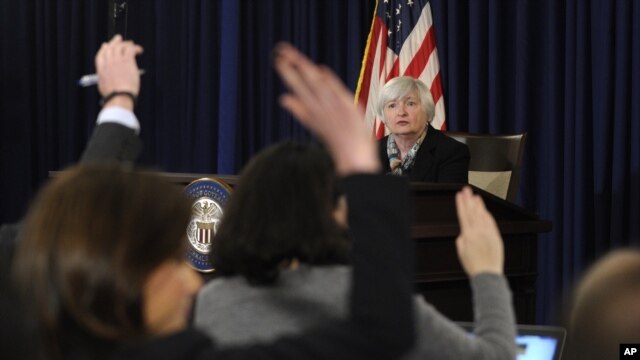US Central Bank to Trim Again Direct Support of American Economy
Federal Reserve Chair Janet Yellen participates in her first news conference at the Federal Reserve in Washington, March 19, 2014.
The U.S. central bank is continuing to cut its direct stimulus of the American economy, the world's largest.
Federal Reserve policy makers said Wednesday that next month, the Fed again will trim asset purchases that are aimed at keeping interest rates low and boosting job growth. They said unusually cold and snowy conditions slowed the U.S. economy this winter, but that there is "sufficient underlying strength" in the economy to push employers to add more workers to their payrolls in the coming months.
New Fed chair Janet Yellen said February's U.S. jobless rate of 6.7 percent is still too high by the country's historical standards, but that bank economists expect the figure will continue to drop throughout the year, perhaps to as low as 6.1 percent, and reach normal levels by 2016.
"The central tendency of the unemployment rate projections has shifted down by about two tenths [of a percent] since December and now stands at between 6.1 and 6.3 percent at the end of this year. The unemployment rate is projected to reach its longer run, normal level by the end of 2016," said Yellen.
The bank last year had been buying $85 billion a month of the assets in an effort to speed the American economy's recovery from the depths of the 2009 recession, the country's worst since the 1930's.
After a two-day meeting in Washington, the Fed said it will cut the purchases to $55 billion in April, down from the current $65 billion figure. It keeps the bank on track to end the purchases altogether later this year, although the Fed said there is no set schedule.
The Fed continued to keep its benchmark interest rate near zero percent and said it will maintain that level "for a considerable time after the asset purchase program ends." It previously had said that its key interest rate could be boosted once the U.S. reached a 6.5 percent jobless rate, but in a policy shift, Yellen said a range of economic factors would be considered before any Fed rate change.
The meeting was the first led by Yellen, the first woman to head the powerful central bank in its century-long history.
Federal Reserve decisions often play a key role in global economic affairs. Some central banks, particularly in emerging economies, have watched warily as the United States begins to withdraw its economic stimulus of the American economy and its interest rates edge slightly higher.
Emerging economy leaders fear that as returns on investment improve in the U.S., investors will withdraw billions of dollars from their countries.
Federal Reserve policy makers said Wednesday that next month, the Fed again will trim asset purchases that are aimed at keeping interest rates low and boosting job growth. They said unusually cold and snowy conditions slowed the U.S. economy this winter, but that there is "sufficient underlying strength" in the economy to push employers to add more workers to their payrolls in the coming months.
New Fed chair Janet Yellen said February's U.S. jobless rate of 6.7 percent is still too high by the country's historical standards, but that bank economists expect the figure will continue to drop throughout the year, perhaps to as low as 6.1 percent, and reach normal levels by 2016.
"The central tendency of the unemployment rate projections has shifted down by about two tenths [of a percent] since December and now stands at between 6.1 and 6.3 percent at the end of this year. The unemployment rate is projected to reach its longer run, normal level by the end of 2016," said Yellen.
The bank last year had been buying $85 billion a month of the assets in an effort to speed the American economy's recovery from the depths of the 2009 recession, the country's worst since the 1930's.
After a two-day meeting in Washington, the Fed said it will cut the purchases to $55 billion in April, down from the current $65 billion figure. It keeps the bank on track to end the purchases altogether later this year, although the Fed said there is no set schedule.
The Fed continued to keep its benchmark interest rate near zero percent and said it will maintain that level "for a considerable time after the asset purchase program ends." It previously had said that its key interest rate could be boosted once the U.S. reached a 6.5 percent jobless rate, but in a policy shift, Yellen said a range of economic factors would be considered before any Fed rate change.
The meeting was the first led by Yellen, the first woman to head the powerful central bank in its century-long history.
Federal Reserve decisions often play a key role in global economic affairs. Some central banks, particularly in emerging economies, have watched warily as the United States begins to withdraw its economic stimulus of the American economy and its interest rates edge slightly higher.
Emerging economy leaders fear that as returns on investment improve in the U.S., investors will withdraw billions of dollars from their countries.


No comments:
Post a Comment